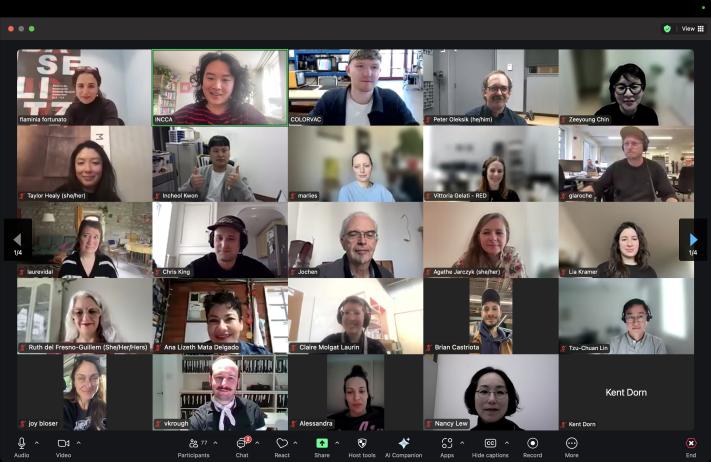
On 18th March, INCCA hosted the INCCA Café: Caring for CRT-based artworks - pitfalls, solutions and current challenges. 82 participants joined this Café.
Florian and flaminia introduced the Café and announced the second initiative on this topic: The Future of the Past: Caring for Picture Tube-Based Art, a two-day conference held at ZKM on 10th and 11th December 2025. More information will follow soon.
The short introduction was followed by three lightning talks led by Incheol Kwon, Taylor Healy, and Peter Oleksik. In the first talk, Conservation and Archiving of Nam June Paik’s CRT-based Artworks, Incheon discussed conservation practices applied to four artworks by Nam June Paik. The multi-year conservation project to preservice The More, The Better (1988) was two-fold. On one hand, CRT monitors were continuously stockpiled, monitored, and cared for; on the other hand, LCD technology was introduced for 6-inch and 10-inch monitors. The second group of works included artist-modified CRT-based installations: Zen for TV (1963), Magnet for TV (1963), and TV Experiment (1969). Incheon spoke about conservation treatments applied to each individual installation and how the collaboration with Nam June Paik technician was fundamental to the preservation of these works. He further mentioned two books that he published at the completion of these restoration projects: 1003+1: the More, the Better. Document of Conservation and Restoration and Conservation Strategies for New Media Artworks. A case study of Nam June Paik’s CRT-based artwork.
In the second talk, Taylor introduced the CRT-based art collection at the Art Institute of Chicago. She grouped the collection in four categories: 1. Non-dedicated equipment pool; 2. Non-dedicated equipment pool flat screens; 3. Dedicated equipment but replaceable; 4. Dedicated and unique. Using the installation Inasmuch as it is already taking place (1990), by Gary Hill as a case study, Taylor highlighted the importance of visual reference of equipment tests in artist interviews. The work-defining properties of the installation became clearer through the process of “seeing” together and discussing subtle equipment behaviour with the artist.
In Caring for Cathode-Ray Tube Technology at the Museum of Modern Art, Peter Oleksik shared the care and preservation challenges encountered at MoMA. Using various CRT-based works recently and currently on view in the museum galleries, Peter spoke about how exhibition often provides the right momentum to focus on these works and prioritize their care. Like AIC and MMCA, MoMA also actively maintains a diversified equipment pool categorized in General Equipment Pool, Legacy Equipment, and Dedicated CRTs. Peter concluded the talk by highlighting the need to engage with the community of museum professionals globally to discuss shared issues as well as to codify findings into a print resource.
The discussion following the presentations created an informal environment where current gaps in knowledge and challenges were addressed. This online event reinforced the need to strengthen the international network of care, define best practices in caring for CRT-based artworks and ultimately consolidate this research in a publication.
The presentation recording is accessible by request.
Find the speakers and moderatos’ bio here.
Photo: Screenshot of INCCA Café: Caring for CRT-based artworks - pitfalls, solutions and current challenges